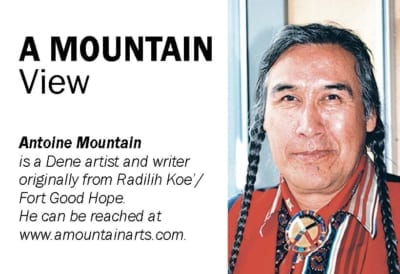Friends, this is the way author and film-maker Raymond Yakeleya says his uncle Johnny Lennie recalls the devastating 1928 flu epidemic.
As related in his about-to-be-released book, We Remember the Coming of the Whiteman, this happened in Tulita, but was a familiar tragedy all along the Duhogah, Mackenzie River.
One figure puts the Indigenous death at a range of from 10 to 15 per cent! This is a great number, given our relatively small population.
The travel vessel, Distributor, was responsible for the way young men were kept busy, just digging graves.
I have a house right next to an old graveyard which was set up right at the time, to take care of the overflow of the dead. There are no individual markers, so they must have been simply dropped into a mass grave.
The way I heard it the chief at the time ordered all the men to go out on the land, collecting bodies which needed burial.
I have been in touch with Raymond Yakeleya over the last several months, for a project with much the same goal in mind as his book.
One of the main aims of Dene Nation president Norman Yakeleya is for a Dene Reunion, to find out about and at least make a record of our People.
As it is you will have no problem finding Dene all the way from the northern Alaskan coast all the way south to the Mexican border.
One of our long-forgotten relatives, though, are the Kets, in Siberian Russia. Word is they speak a language very similar to ours.
I have been to that very area a total of five times, from the early 2000's, when the Government of the NWT took part in Siberfest, an event for the circumpolar native Peoples.
I personally believe there is a very strong connection to the Kets, because on a tour of the Siberian Russia/Mongolian border country I had a total of five déjà vu's, and one right at the gates to the dwelling of a famed shaman's son!
Raymond Yakeleys's new book also began as a reworked version of his Seventies film, The Last Mooseskin Boat.
Those times are also included in my first book, From Bear Rock Mountain; The Life and Times of a Dene Residential School Survivor. It was some wild ride, let me tell you, out of the mountains, back to the river!
Both Raymond and I feel that the youth of today need these ways to help preserve their Dene identity.
My Indigenous PhD Studies also includes this major purpose as its research proposal. Indeed, our traditional Dene Burial customs will be the focus of my work with the young people of Radelie Koe, Fort Good Hope, this coming summer.
For now, we should be truly grateful for those like Raymond Yakeleya, who in their way bring yesterday back to the light of day. Mahsi, thank you.
